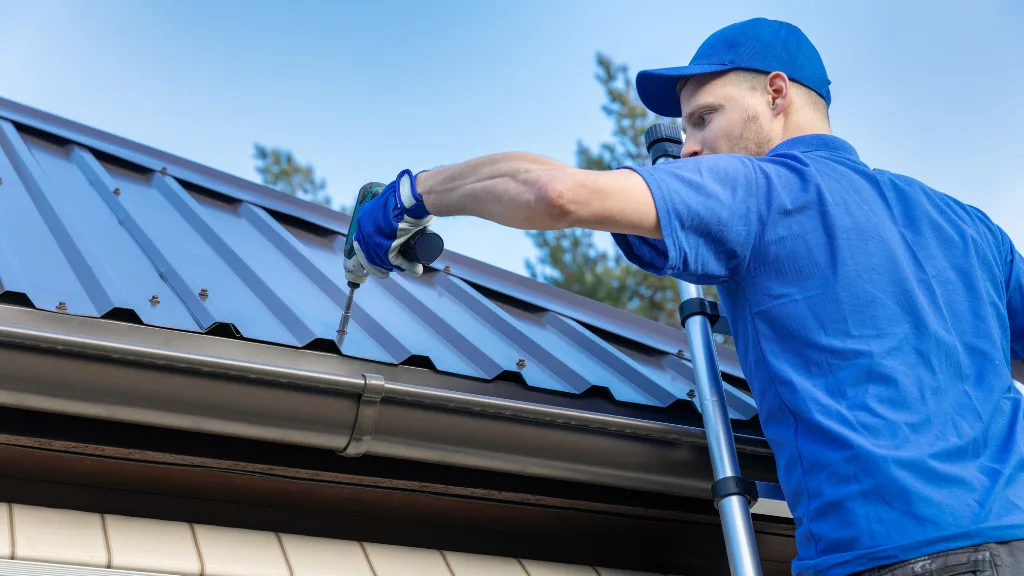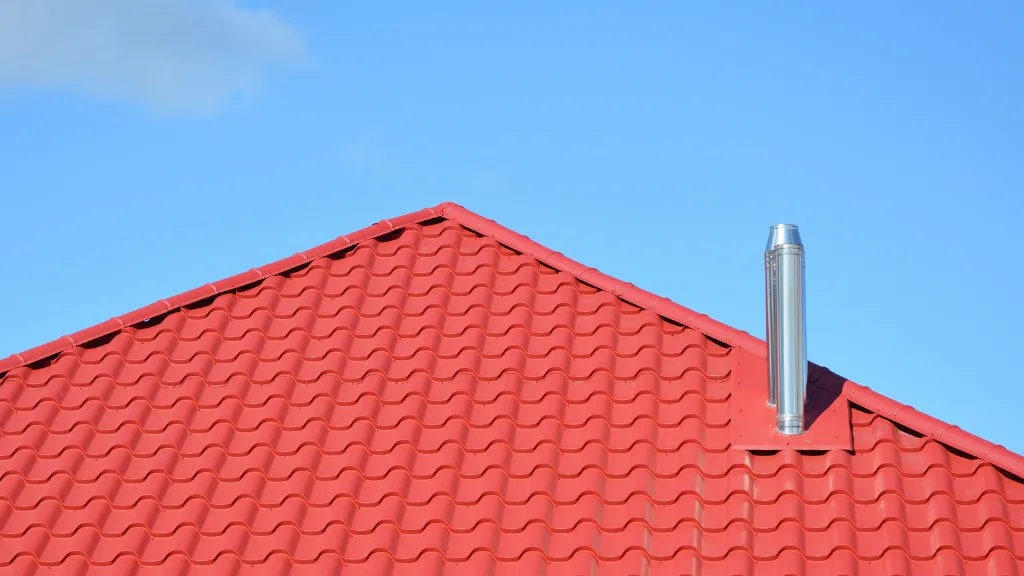
Metal roofs are more popular than ever before. They are durable, resist rust and fire, and can last for decades with the right care.
When you install a metal roof on your home or business, it’s important to use an underlayment that will protect the materials from moisture damage.
This blog post is here to help you decide which underlayment is best for your needs!
What are Roofing Underlayments?
Underlayments are materials that protect your roof. They act as a barrier between the elements and the actual structure of your metal roof, so they need to be dependable.
There are three main types of underlayment for roofs:
1. Roofing felt is one type of underlayment used for many kinds of structures, including metal roofs.
It’s a durable, flexible material that protects the roof from water damage. Felt is made of organic fibers and coated with asphalt or other substances to make it waterproof.
2. Tar paper is another type of underlayment for metal roofs.
Tar paper has an extremely high resistance to heat, so it can be used on roofs in locations where there is a lot of sun exposure.
It’s also resistant to tearing, water damage, and other weather conditions that can compromise the roofing material.
3. Polyethylene is an extremely strong underlayment for roofs made from metal or other materials.
The plastic membrane often comes in rolls and must be cut down to size. Polyethylene works well on roofs that are pitched at a steep angle.
Felt Roofing Underlayment
Felt roofing underlayment has been used for decades to provide protection against weather-related damage.
Using felt roofing underlayment is a time honoured technique, with most blueprints dating back hundreds of years!
Felt roofing underlayments are generally made using felted organic materials such as jute or cotton.
- While the idea of using underlayment is not new, the type of underlayment has evolved over time.
- Modern felt roofing underlayments are highly efficient at preventing weather damage and come in a variety of thicknesses to accommodate different types of roofs.
- Many felt roofing underlayments also utilise synthetic materials to increase their efficiency.
- Felt roofing underlayments are important to the life of a roof.
- Not only do they protect against weather damage, but they also prevent leakage which ensures that water damage is reduced to a minimum.
- While there are several different types of felt roofing underlayment available, it’s important to note that not all products are created equally.
- For example, there is a difference between using organic and synthetic felt roofing underlayment.
- Organic materials can provide increased protection, however they do not work as well in high temperatures or tend to be more expensive than their synthetic counterparts which are easier to install as well as having increased strength.
When it comes to choosing the right felt roofing underlayment, it is important to take into account the climate and additional weather conditions.
This will ensure that your roofing underlayment protects you and your home as expected, every time.
Tar Paper Underlayment
Tar paper underlayment is a product used in roofing to add an extra layer of protection against leaks and is generally made up of highly saturated felt paper with asphalt on one side.
Tar paper is most commonly used in asphalt shingles, which are the most common type of roofing.
There are two types of tar paper underlayment you can do, either with the seams exposed or done fully exposed.
- The exposed seam method involves placing full panels next to each other after having exposed the sticky side of each panel by tearing off the paper facing.
- Be sure that the seams butt tightly against each other and do not overlap when you install this type of tar paper underlayment.
- The fully exposed method is much simpler and involves stapling the entire perimeter of the sheet and laying it down with no overlapping or exposed seams at all.
- This method also provides an extra measure of protection from leaks.
- You can use either studs or truss clips to attach the underlayment, depending on how it will be installed.
- If you are using a fully exposed method where you do not have seams, tar paper underlayment nails will work fine.
- For an exposed seam method, you need to use specially designed boards that hold the seam open while you staple.
Tar paper underlayment is generally installed with either an asphalt shingle or a metal roofing system, but it can be used under other types of roofing material if needed.
It provides additional protection against leaks and also adds extra stiffness to the membrane beneath it.
Polyethylene Underlayment is
Polyethylene underlayment is a material that is placed under tiles or other flooring materials, providing an even surface for them to be installed on.
It helps protect the subfloor from damage and helps with moisture wicking to keep mold and rot at bay.
- The material comes in large rolls that are 100 feet long. The width varies depending on the manufacturer but they are usually either 4 or 6 feet wide.
- Polyethylene Underlayment is not a self-supporting panel; it will need to be supported by the subfloor (such as plywood, OSB, etc.) and structural floor joists.
- It must span three joists at minimum and can span up to 10′.
- If it is stapled or adhered to the subfloor, it must be placed over joists. Beads are used along walls to help with expansion.
- Polyethylene Underlayment can span up to 10 feet, but it will sag if there are no supports underneath.
- If you will need longer spans or an area that has beams, you will need to use a product designed for those situations, such as rubberized asphalt underlayment.
- When using laminate flooring, always install the Polyethylene Underlayment so that it is smooth and flat.
- When used on concrete or clay surfaces, be sure the surface is dry and clean.
- Polyethylene underlayment when used for a roofing system, should be installed tight to the joists.
- The minimum recommended height is 2 1/4 inches, but it can be installed in height increments of no less than two inches.
- When used for a roofing system, the seams should be sealed with underlayment tape or adhesive designed for that application.
- Although it comes in black, Polyethylene Underlayment is actually available in a wide array of colors for aesthetic applications.
Main function is to provide an even surface for flooring installation as well as protection from moisture damage and mold/rot formation as well as give structural stability to the installation.
Why Are Roofing Underlayments Important?
Roofing underlayments are your roof’s first line of defense against leaks. They act as a shield between the roof and the material that will be installed on top of it, like shingles or tiles.
Seams in materials like asphalt shingles can let water seep through. Underlayment with self-sealing strips join the seams to keep water out.
Many types of underlayment exist, and each material has its own advantages and disadvantages. Knowing the pros and cons of each could help you decide which type of underlayment is best for your roof.
Here are the top reasons why you need roofing underlayments:
Pro: They Keep the Roof Dry
Underlayment forms a moisture barrier underneath shingles and tiles. This makes it easier to keep roofs completely dry, which is very important.
Water can damage wood planks and joints that hold together your roof’s structure. It may also cause problems inside your home like mold growth and rot in window sills and door frames.
Pro: They Protect the Roofing Material
Since underlayments act as a shield between the roof deck and whatever you plan to put on top of it, they keep your materials safe.
Layers of shingles or tiles are strong individually, but may deteriorate when stacked up against wood beams or nails that hold your roof together.
Underlayment acts as a cushion between the underlayment and the above layers, which protects all of these materials from damage.
Pro: They can Prolong Your Roofing Materials Lifespan
Your roofing material’s lifespan depends on where you live, how strong the winds are in your area, whether or not it snows a lot where you are located, and other factors.
However, while even the best roofing materials will still begin to deteriorate over time, underlayment can prolong the life of your materials.
Con: They Can Add to Weight
Roofing underlayments are usually made of heavy rubber or plastic. This can add extra weight, making roofs more likely to collapse if they’re already weak.
Also, adding extra weight to the roof makes it harder for your home’s foundation to support its weight.
Con: They Can Increase Cost
Roofing underlayments are usually sold by the roll and charged per square foot of coverage area.
This can add up fast, especially if you’re covering a large roof or using an expensive type of underlayment.
Con: They Can Slide
In places where the roof surface is very steep or angled, roofing underlayments can slide down.
This happens because they’re not glued to the deck and get pushed around by wind and rain. In this case, a sturdier material like felt paper may be a better option.
Con: They Can Cause Ice Dams
Ice dams are formed when snow is caught on the edge of a roof, causing water to seep under shingles and melt.
As it does, this adds to the volume of water that flows into your gutter or down your roof’s surface.
With no way to escape, the dam grows until it fills the entire space under your shingles.
Roofing underlayments often have seams that are sewn together. During extremely cold weather, water can freeze in these seams and block drainage to create an ice dam.
However, there are roofing underlayments that don’t have this problem. Some use waterproof materials that never let moisture through, like rubber or plastic.
Others use seams that can expand and contract as needed to help water escape under them.
Therefore, among the 3 types of underlayment; roofing felt is the best roofing underlayment.
A roofing felt can help prolong the lifespan of your roofing system as well as make it stand strong against harsh weather conditions.
However, make sure that you understand that underlayments must be able to conform well to different roof structures or shapes.

